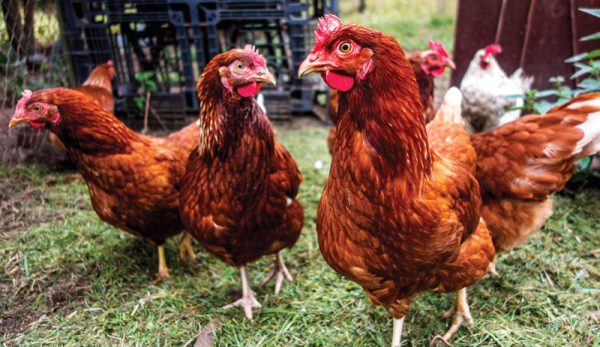
Small-scale poultry flocks are susceptible to a number of respiratory infections, some producing extremely mild illness while others result in high fatality rates. Regardless of whether you raise chickens for eggs, meat or show, a respiratory infection can result in decreased performance and even death in cases such as Newcastle disease and avian influenza, which are now rare in the U.S. They can also pose a threat to the health of other poultry on the premises.
Respiratory infections in poultry have several causes, but outward signs might appear similar to the poultry keeper. In any case of respiratory illness, it’s important to know if you’re dealing with a viral, bacterial, fungal or parasitic disease. The treatment for one disease can be ineffective or even harmful for others, which is why it is imperative to partner with a qualified avian veterinarian in making an accurate diagnosis and determine a treatment and management plan. Do not rely on home remedies. In addition to the chance that they won’t work, they might also mask key indicators of a disease, making diagnosis more difficult or inaccurate.
If you suspect that a chicken is ill, immediately isolate it from the rest of the flock. To make a diagnosis, your veterinarian will perform several tests, including blood tests and bacterial cultures of the airways. A fecal test for parasites, including tapeworms, which can lodge in the trachea and cause severe respiratory distress, should be conducted, as well.
For bacterial infections, such as fowl cholera (aka Pasteurellosis), infectious coryza and avian mycoplasmosis, your veterinarian can prescribe an antibiotic to alleviate symptoms of the disease. However, keep in mind that in the case of infectious coryza, the antibiotic won’t eliminate carrier status, and in the case of avian mycoplasmosis, treatment with antibiotics won’t cure the disease.
Aspergillosis, aka brooder pneumonia, does not usually present with a cough but instead with a characteristic silent gasp and is caused by fungal organisms, Aspergillus spp., that grow readily in organic materials. If large numbers of the organisms or their spores are inhaled, they can multiply in the bird’s air sacs and spread throughout the respiratory tract. Treatment for aspergillosis involves antifungal drugs and is typically a lengthy and expensive process.
If the chicken dies before your veterinarian is able to provide a diagnosis, immediately refrigerate the carcass. (Do not freeze it.) Ideally, your veterinarian should perform a necropsy within hours of death.
Using good biosecurity practices will help reduce the incidence of communicable respiratory illness in small-scale flocks. It’s important to develop and implement a biosecurity plan for the health and safety of your poultry and your farm.
- Always obtain hatching eggs and replacement stock for your flock from a reputable hatchery or dealer who participates in the National Poultry Improvement Plan, a USDA program that tests and monitors a number of avian diseases.
- If possible, house chickens by age group, separating younger birds from older members of the flock. Young poultry need time to develop immunity.
- Limit farm visitors’ access to your flock to prevent the spread of infectious agents. If a visitor would like to see your chickens, ask them to wear freshly laundered clothes and clean footwear and request that they avoid contact with any other birds the day of their visit.
- Quarantine new flock members for at least three weeks. During this time, ask your veterinarian to test the birds’ blood for antibodies and conduct a fecal parasite screening.
- Provide clean living quarters for your flock. Remove manure frequently (both viruses and parasites are shed via feces), and immediately discard any feed or bedding that becomes wet. Coarse bedding is preferable to fine as it produces less dust.
- Ensure good ventilation in buildings where you keep your flock.
- After returning from a show or fair, quarantine chickens and other poultry for two to three weeks and monitor them closely for any signs of illness or disorders. The combination of a large group of birds and close quarters makes shows and fairs common sites for the transfer of communicable organisms, resulting in respiratory outbreaks.
In addition to practicing good biosecurity, consider putting a vaccination program in effect with your flock. This is particularly valuable in preventing outbreaks of viral infection, for which there is no treatment. Contact a local veterinarian who knows avian medicine or an extension poultry specialist; he or she can answer your questions and recommend a program appropriate for your needs.
About the Authors: Eva Wallner-Pendleton, D.V.M., M.S., A.C.P.V., is a senior research associate, avian pathologist and field investigator, Animal Diagnostic Lab, Pennsylvania State University College of Veterinary Sciences. Dr. Lyle G. McNeal is a livestock specialist in the Department of Animal, Dairy and Veterinary Services at Utah State University.
This article originally appeared in the November/December 2013 issue of Hobby Farms.




